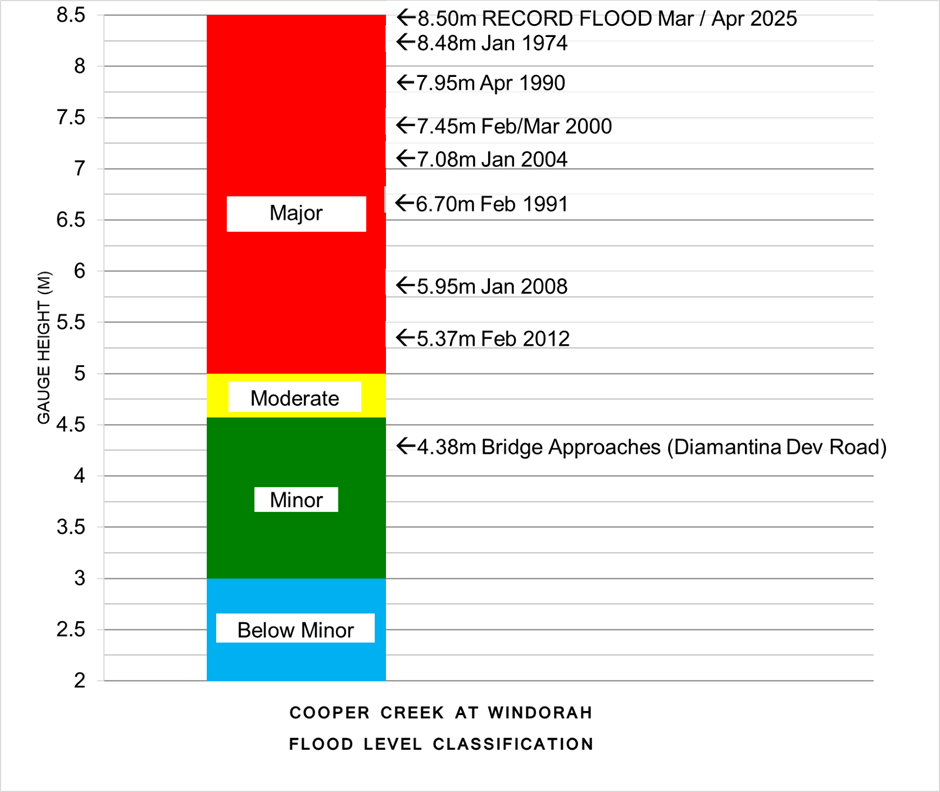This brochure describes the flood risk and previous flooding in the Thomson/Barcoo/Cooper
River catchment, last updated in July 2025.
Flood Risk
The Thomson-Barcoo-Cooper catchment drains an area of approximately 237,000 square kilometres and is part of the largest basin in Queensland, the Lake Eyre Basin. The Lake Eyre Basin is the largest and only internal drainage system in Australia with no external outlet, and it covers over 1.2 million square kilometres of central Australia. Floodwaters reach Lake Eyre usually after major flood events in the Cooper Creek catchment.
The two main tributaries, the Thomson and Barcoo Rivers, merge into the Cooper Creek approximately 40 kilometres upstream of Windorah. The Thomson River and its tributaries flow in a general southwesterly direction and it has several of the larger towns of the region, including Longreach and Muttaburra, along its banks. The Barcoo River flows in a general westerly direction and has major centres such as Isisford, Blackall, Barcaldine, Jericho and Tambo in its catchment.
The Thomson-Barcoo-Cooper catchment can be divided into two distinct areas:
Upstream of Windorah, numerous well-defined creeks and channels flow into the Thomson and Barcoo Rivers.
Downstream of Windorah, the typical wide-ranging channel country develops along the Cooper Creek.
In the dry season, the channels are restricted to numerous lagoons and claypans. During the wet season, the actual main channel becomes hard to define, particularly when the river at Windorah could be up to 40 kilometres wide. Below this point, however, in a big flood, the area becomes a huge inland sea broken only by a few ridges and numerous stunted trees.
Major flooding requires a large-scale rainfall event over the Thomson and Barcoo Rivers and Cooper Creek catchment. The following can be used as a rough guide to the likelihood of flooding in the catchment:
75 mm in 24 hours over isolated areas, with lesser rainfall of 50 mm over more extensive areas will cause stream rises and the possibility of minor flooding. If lesser rainfalls have been recorded in the previous 24 to 72 hours, then moderate to major flooding may develop.
100 mm in 24 hours will cause isolated flooding in the immediate area of the heavy rain.
100 mm or heavier falls in 24 hours over a wide area will most likely cause major flooding, particularly in the middle to lower reaches of the Thomson and Barcoo Rivers extending downstream to Windorah on Cooper Creek.
Previous Flooding
Records of large floods in the area extend back as far as the late 19th century, with the most significant episodes of flooding occurring in 1893, 1906, 1949, 1955, 1963, 1974, 1990, 2000, and 2025. Some of the more recent floods are summarised in table form:
| Flood Event | Jericho | Barcaldine | Blackall | Isisford | Camoola Park | Longreach | Stonehenge | Jundah | Windorah |
| Mar 1971 | - | - | - | - | 2.84 | 3.30 | 5.94 | 7.54 | 7.65 |
| Jan 1974 | - | - | - | 6.83 | 7.16 | 6.82 | 6.88 | 8.38 | 8.48 |
| Apr 1990 | 3.80 | 8.96 | 7.30 | 9.20 | 6.80 | 6.37 | 5.86 | 7.55 | 7.95 |
| Feb 1991 | - | - | - | 4.25 | 5.52 | 5.71 | 4.70 | 6.45 | 6.70 |
| Feb/Mar 2000 | - | - | - | 3.28 | 7.42 | 6.95 | 6.42 | 7.85 | 7.45 |
| Jan 2004 | - | - | 4.25 | 7.39 | 4.60 | 5.03 | 5.16 | 6.68 | 7.08 |
| Jan 2008 | 3.08 | - | 5.15 | 8.68 | 4.65 | 5.28 | 3.80 | 5.20 | 5.95 |
| Mar 2010 | - | - | 3.97 | 5.40 | - | - | - | 3.80 | 5.50 |
| Dec/Jan 10/11 | 3.80 | - | 5.51 | 6.97 | - | 4.62 | - | 4.05 | 5.22 |
| Feb 2012 | 3.39 | - | 7.02 | 7.39 | 4.30 | 4.76 | 3.00 | 4.32 | 5.37 |
| Mar/Apr 2019 | 2.5 | - | - | 7.56 | 3.10 | 6.16 | 4.10 | 5.75 | 6.16 |
| *Mar/Apr 2025 | - | - | - | 6.13 | 5.10 | 5.36 | 7.40 | 8.70 | 8.50 |
All heights are in metres on flood gauges.
*Preliminary values subject to verification




Further Information:
- Latest rainfall and river heights
- For information on the flood warning service for the Thomson and Barcoo Rivers and Cooper Creek: Queensland Service Level Specification
- Thomson and Barcoo Rivers and Cooper Creek Catchment map: Queensland Bulloo, Thomson/Barcoo/Cooper map
- National Arrangements for Flood Forecasting and Warning









